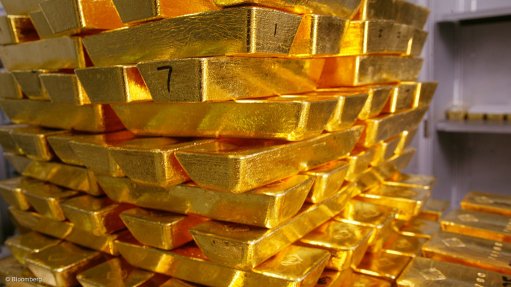
Photo by: Bloomberg
JOHANNESBURG (miningweekly.com) – Physical demand for gold remained at “pitiful levels” for the third successive quarter, down 30% year-on-year in the three months to September 30, hindered by sharply higher prices in the aftermath of the British referendum to leave the EU (Brexit), reports markets analyst Thomson Reuters GFMS.
Nevertheless, the firm’s latest gold survey shows that multiyear price highs have helped to send scrap flows up by a fifth, thereby taking total supply to a level that matches the highest quarterly amount, last recorded in the fourth quarter of 2012.
The survey highlighted that demand for gold exchange-traded funds (ETFs) remained healthy over the [US] summer, though it was still “markedly slower” than in the first half of 2016. This ensured that the net surplus was at its highest since the fourth quarter of 2005. “Given this backdrop, it was unsurprising that gold prices faltered at the beginning of October,” stated Thomson Reuters.
The survey also pointed out that the gold market’s attention had “clearly shifted” during the past quarter from Brexit to the US presidential election. “A Donald Trump victory could spark a rally to $1 400 – and maybe even to $1 500, in our view – while a win for Hillary Clinton would likely see prices ebb lower,” noted the firm.
DEMAND
The third quarter of 2016 started with ETF purchases and speculative buying in the west – the key driver that had prevailed over the first half of the year – sending the gold price up to multiyear highs in July.
However, the survey noted that this only exacerbated the “appalling” state of physical demand. As a result, jewellery fabrication was down 27% year-on-year at 409 t in the third quarter, while offtake was down in all regions, with the most dramatic declines coming from Asia. The two largest markets, India and China, saw yearly jewellery consumption down 41% and 27% respectively, despite an improvement in quarter-on-quarter demand.
Thomson Reuters commented, however, that this relative improvement was largely a reflection of seasonal factors, and jewellery consumption in 2016 appeared set to record a seven-year low in China and a 13-year low in India.
This is despite these countries’ gross domestic products (GDPs) being less than half this year’s level when they last recorded their lowest consumption levels.
Retail investment had similarly shrunk sharply across much of the world, falling 29% year-on-year. In contrast to jewellery, however, the sharpest declines were often in western markets, with price-sensitive coin buyers reducing their purchases appreciably when compared with the “stellar levels” of (the US) summer in 2015, although purchase levels were stronger in the same quarter of 2013 and 2014.
Thomson Reuters remarked that the global picture would have been even weaker if not for Chinese investment demand, which was up 11%. Demand also halved from central banks and the downtrend in demand from industrial applications continued. The sharp decline from the official sector was attributed to the “markedly slower” pace of purchases from Russia and China, along with higher sales from Venezuela.
SUPPLY
The survey found that gold mine production had continued to contract, slipping to 822 t in the third quarter – a 2% year-on-year decrease – as the effect of earlier cuts in capital expenditure from miners fed through into fewer new projects, decreasing output at existing operations.
The survey also indicated that total supply was hindered in the third quarter by miners returning to dehedging. Thomson Reuters highlighted that, despite this outcome, total supply was at its joint highest level since the closing quarter of 2012, with scrap soaring as the market responded rapidly to the stark price appreciation at the start of the quarter. “Indeed, Indian scrap supply was at its highest in our quarterly series, which dates back to the start of 1999.”
MARKET BALANCE
Thomson Reuters remarked that, given all these factors, the gold market is, as in the first half of the year, heavily contingent on ETF demand for balance and, while ETF demand exceeded 100 t for the third successive quarter, this was insufficient to prevent a surplus at the net balance level of over 250 t.
“This was the largest quarterly surplus since the fourth quarter of 2005 and makes the price correction in early October unsurprising,” the survey said.
PRICE OUTLOOK
Thomson Reuters believes that the recent gold price decline is a “healthy correction” for the market. However, the firm emphasises that it will be “no more than that” as it believes that gold is set to stay well above last year’s price lows as it continues to “comfortably” exceed $1 200/oz, with a potential low of $1 240/oz.
“We forecast that, with prices stabilising at these lower levels, physical demand, particularly in Asia, will spark to life and underpin gold prices. ETF demand in the west is also set to remain at healthy levels with a growing number of financial institutions recommending gold purchases in a world with trillions of dollars of negative yielding bonds. Consequently, we forecast gold prices to average $1 420 in 2017,” Thomson Reuters concluded.